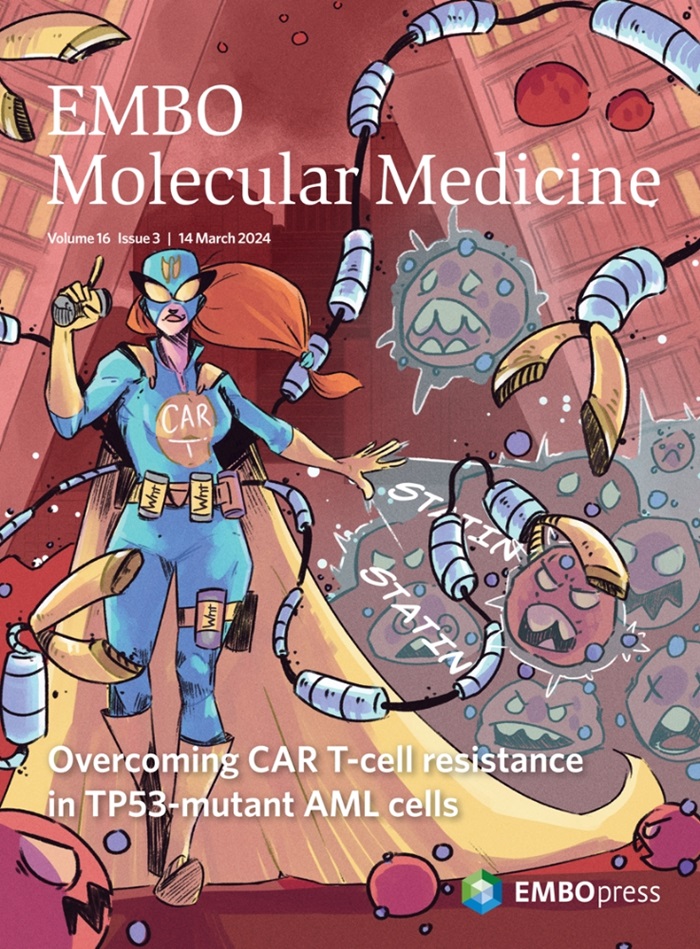白色脂肪组织的棕色重塑通过batokine FSTL1保护腹主动脉瘤。
IF 8.3
1区 医学
Q1 MEDICINE, RESEARCH & EXPERIMENTAL
引用次数: 0
摘要
腹主动脉瘤(AAA)是一种危及生命的血管疾病,目前尚无有效的药物治疗方法。新出现的证据表明脂肪组织和血管细胞之间存在一种串扰。此外,棕色脂肪组织被认为对心血管健康有益。然而,白色脂肪组织的棕色重塑是否能预防AAA仍不清楚。在这里,我们发现AAA患者的脂肪组织褐变水平降低,诱导脂肪组织褐变可显著降低小鼠AAA的发病率和减轻AAA的发展。通过LC-MS/MS和蛋白质组学分析,我们进一步确定了卵泡素抑制素样1 (FSTL1)是一种由褐变脂肪细胞分泌的新型血管保护脂肪因子。机制上,FSTL1通过DIP2A/AKT信号通路抑制VSMC凋亡。此外,我们证明了脂肪细胞特异性FSTL1的缺乏取消了褐变诱导的保护作用。此外,全身补充FSTL1或将FSTL1贴片到腹主动脉周围的水凝胶中,可显著限制主动脉扩张和AAA进展。我们的数据表明,脂肪组织褐变和细胞因子FSTL1在AAA的发展中具有保护作用,这可能代表了一种新的AAA干预策略。本文章由计算机程序翻译,如有差异,请以英文原文为准。
Brown remodeling of white adipose tissue protects against abdominal aortic aneurysm via batokine FSTL1.
Abdominal aortic aneurysm (AAA) is a life-threatening vascular disease without effective medical therapies. Emerging evidence have suggested a crosstalk between adipose tissue and vascular cells. Besides, brown adipose tissue is considered beneficial for cardiovascular health. Nevertheless, whether brown remodeling of white adipose tissue would protect against AAA remains unclear. Here, we showed that patients with AAA had a decreased browning level of adipose tissue, and induction of adipose tissue browning significantly reduced AAA incidence and attenuated AAA development in mice. Using LC-MS/MS and proteomic analysis, we further identified Follistatin-like 1 (FSTL1) as a novel vessel-protective adipokine secreted by browning adipocytes. Mechanistically, FSTL1 inhibited VSMC apoptosis through DIP2A/AKT signaling. Furthermore, we demonstrated that adipocyte-specific deficiency of FSTL1 abrogated the protective effect of browning induction. Moreover, supplementation of FSTL1 either systemically or patched into hydrogel placing around the abdominal aorta markedly limited aortic dilation and AAA progression. Our data suggest a protective role of adipose tissue browning and batokine FSTL1 in the development of AAA, which may represent a novel intervention strategy for AAA.
求助全文
通过发布文献求助,成功后即可免费获取论文全文。
去求助
来源期刊

EMBO Molecular Medicine
医学-医学:研究与实验
CiteScore
17.70
自引率
0.90%
发文量
105
审稿时长
4-8 weeks
期刊介绍:
EMBO Molecular Medicine is an open access journal in the field of experimental medicine, dedicated to science at the interface between clinical research and basic life sciences. In addition to human data, we welcome original studies performed in cells and/or animals provided they demonstrate human disease relevance.
To enhance and better specify our commitment to precision medicine, we have expanded the scope of EMM and call for contributions in the following fields:
Environmental health and medicine, in particular studies in the field of environmental medicine in its functional and mechanistic aspects (exposome studies, toxicology, biomarkers, modeling, and intervention).
Clinical studies and case reports - Human clinical studies providing decisive clues how to control a given disease (epidemiological, pathophysiological, therapeutic, and vaccine studies). Case reports supporting hypothesis-driven research on the disease.
Biomedical technologies - Studies that present innovative materials, tools, devices, and technologies with direct translational potential and applicability (imaging technologies, drug delivery systems, tissue engineering, and AI)
 求助内容:
求助内容: 应助结果提醒方式:
应助结果提醒方式:


